|
 Secure Site
Secure Site
|
 |
Archive for the 'Meditation Timers' Category
 meditation reduces stress Dhyana heyah tad vrttayah.
Meditation removes disturbances of the mind. (Yoga Sutra II.11)
Research also shows that meditation can help people with anxiety disorders. Philippe Goldin, director of the Clinically Applied Affective Neuroscience project in the Department of Psychology at Stanford University, uses mindfulness meditation in his studies. The general practice is to become aware of the present moment—by paying attention to sounds, your breath, sensations in your body, or thoughts or feelings—and to observe without judgment and without trying to change what you notice.
Like most of us, the participants in Goldin’s studies suffer from all sorts of disturbances of the mind—worries, self-doubt, stress, and even panic. But people with anxiety disorders feel unable to escape from such thoughts and emotions, and find their lives overtaken by them. Goldin’s research shows that mindfulness meditation offers freedom for people with anxiety, in part by changing the way the brain responds to negative thoughts.
In his studies, participants take an eight-week mindfulness-based course in stress reduction. They meet once weekly for a class and practice on their own for up to an hour a day. The training includes mindfulness meditation, walking meditation, gentle yoga, and relaxation with body awareness as well as discussions about mindfulness in everyday life.
Before and after the intervention, participants have their brains scanned inside an fMRI (or functional MRI) machine, which looks at brain activity rather than the structure of the brain, while completing what Goldin calls “self-referential processing”—that is, thinking about themselves. An fMRI scanner tracks which brain areas consume more energy during meditation and, therefore, which regions are more active.
Ironically, the brain-scanning sessions could provoke anxiety even in the calmest of people. Participants must lie immobilized on their back with their head held in the brain scanner. They rest their teeth on dental wax to prevent any head movement or talking. They are then asked to reflect on different statements about themselves that appear on a screen in front of their face. Some of the statements are positive, but many of them are not, such as “I’m not OK the way I am,” or “Something’s wrong with me.” These are exactly the kinds of thoughts that plague people with anxiety.
The brain scans in Goldin’s studies show a surprising pattern. After the mindfulness intervention, participants have greater activity in a brain network associated with processing information when they reflect on negative self-statements. In other words, they pay more attention to the negative statements than they did before the intervention. And yet, they also show decreased activation in the amygdala—a region associated with stress and anxiety. Most important, the participants suffered less. “They reported less anxiety and worrying,” Goldin says. “They put themselves down less, and their self-esteem improved.”
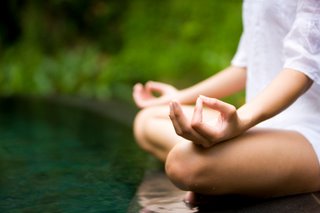 reduce stress with meditation Goldin’s interpretation of the findings is that mindfulness meditation teaches people with anxiety how to handle distressing thoughts and emotions without being overpowered by them. Most people either push away unpleasant thoughts or obsess over them—both of which give anxiety more power. “The goal of meditation is not to get rid of thoughts or emotions. The goal is to become more aware of your thoughts and emotions and learn how to move through them without getting stuck.” The brain scans suggest that the anxiety sufferers were learning to witness negative thoughts without going into a full-blown anxiety response. Research from other laboratories is confirming that mindfulness meditation can lead to lasting positive changes in the brain. For example, a recent study by Massachusetts General -Hospital and Harvard University put 26 highly stressed adults through an eight-week mindfulness-based course in stress reduction that followed the same basic format as Goldin’s study. Brain scans were taken before and after the intervention, along with participants’ own reports of stress. The participants who reported decreased stress also showed decreases in gray -matter density in the amygdala. Previous research had revealed that trauma and chronic stress can enlarge the amygdala and make it more reactive and more connected to other areas of the brain, leading to greater stress and anxiety. This study is one of the first documented cases showing change ocurring in the opposite direction—with the brain instead becoming less reactive and more resilient.
Together, these studies provide exciting evidence that small doses of mental training, such as an eight-week mindfulness course, can create important changes in one’s mental well-being.
adapted from Yoga Journal, by Kelly McGonigal
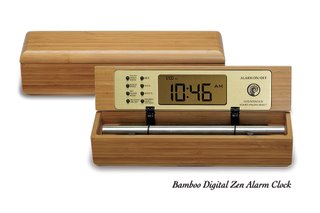 Bamboo Digital Zen Alarm Clock by Now & Zen Now & Zen’s Meditation Timer Store
1638 Pearl Street
Boulder, CO 80302
(800) 779-6383
Posted in Bamboo Chime Clocks, intention, Meditation Timers, Meditation Tools, mindfulness practice, Now & Zen Alarm Clocks, Well-being, Zen Timers
 yoga supported fish pose Beat the Blues
You can see next week’s deadlines and responsibilities building up like a wave about to crest.
Take a few moments of silence to coil your energy before you dive into another week. This pose helps ward off the Monday-morning blues, inviting energy into your body and mind.
Supported Fish
What It Does
Stretches the shoulders, neck, and chest; improves posture and deepens breathing, countering a forward hunch. Opens the heart and the throat chakras, bolstering courage and encouraging authentic expression.
How to Do It
Set your Zen Yoga Timer in Bamboo to chime after 5 minutes. Roll up a thin blanket and lie on your back, resting your shoulder blades on the blanket. If your head doesn’t comfortably reach the floor, place another blanket or small pillow underneath.
Let your breath rise and fall naturally, and stay here for 5 minutes, or as long as you like.
adatped from Body + Soul, 2010
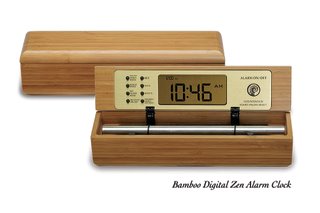 Bamboo Digital Chime Clock, a calming timer and alarm clock made from natural materials like bamboo, walnut, and maple Now & Zen’s Yoga Timer Store
1638 Pearl Street
Boulder, CO 80302
(800) 779-6383
Posted in Bamboo Chime Clocks, Japanese Inspired Zen Clocks, Meditation Timers, Meditation Tools, Now & Zen Alarm Clocks, Yoga Timer, Yoga Timers by Now & Zen
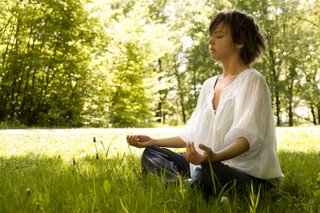 lovingkindness meditation Put it into practice.
Sit comfortably in a place where you won’t be disturbed. Take three to five quiet breaths. Gently close your eyes.
Imagine the horizon spanning through your chest with a radiant sun rising in your innermost center—your heart. As though being melted by the solar warmth, release tension in your shoulders and across your throat. Soften your forehead and rest your attention inward on the light deep within. Take 7 to 10 smooth, even breaths.
As you inhale, invite the glow from your heart to expand toward the inner surface of the body. With each exhale, let the light recede. Take another 7 to 10 peaceful breaths. Inhaling, invite the light to touch the parts of you that interact with the world—your eyes and ears, the voice center in your throat, the palms
of your hands, the soles of your feet. Exhaling, feel your light shine more clearly. As you continue to inhale and exhale, silently say: “I radiate friendliness for those who are happy, com-passion for those who are unhappy, equanimity toward all.” Continue until your attention wavers. Then, sit quietly for several minutes.
When you feel complete, place your palms together in front of your heart and bow your head. Release the backs of your hands to your thighs and lift your head. Gently open your eyes to return to the horizon of the world.
adapted from Yoga Journal, byKelly McGonigal
Use our unique “Zen Clock” which functions as a Yoga Timer. It features a long-resonating acoustic chime that brings your meditation or yoga session to a gradual close, preserving the environment of stillness while also acting as an effective time signal. Our Yoga Timer & Clock can be programmed to chime at the end of the meditation or yoga session or periodically throughout the session as a kind of sonic yantra. The beauty and functionality of the Zen Clock/Timer makes it a meditation tool that can actually help you “make time” for meditation in your life. Bring yourself back to balance.
 bamboo meditation timer Now & Zen – The Portable Meditation Timer Store
1638 Pearl Street
Boulder, CO 80302
(800) 779-6383
Posted in Bamboo Chime Clocks, intention, Meditation Timers, Meditation Tools, mindfulness practice, Now & Zen Alarm Clocks, Well-being, Zen Timepiece by Now & Zen, Zen Timers
 Utamaro Kitagawa, The Courtesan Hanaogi of Ogiya, Ukiyo-e Woodblock Print As far back as 300 B.C., the philosopher Chuang Tzu observed that when an archer was practicing, he shot with calming relaxation and skill. When a moderate financial award was placed in front of the archer, he got a little tense, his aim faltered and he often missed the target. When a large award was offered for his accuracy, he became nervous and worried, with obvious results. This led Chuang Tzu to wryly observe that, “He who looks too hard on the outside gets clumsy on the inside.”
In modern times people who play golf find their swing is near perfect when there is no ball to hit. But once a ball is placed on the tee and someone is keeping score, the inexperienced golfer’s swing inevitably fails and the ball goes off its intended path. When a golfer has a drink, he often becomes more relaxed and his game improves. So even though a specific feat can be improved by artificial means, it is at the expense of our being fully present and reduces our ability to respond to other circumstances. Imagine how our performance in everyday life would improve if we could learn to find rest and calming relaxation from within ourselves.
The question is, “How could we relax in the process of living?” or, “How can we have rest in our daily lives? How do we live for the rest of our lives?”
 Ohara Koson (Shoson) 1877-1945, Ukiyo-e Here are six resting points or techniques that can assist us in finding rest and calming relaxation, peace, tranquility, and restoration within ourselves and within the great self that embraces and holds us all. Try one and you’re on your way to the rest of your life.
1. The Breath: Following the rise and fall of your breath can bring you to a peaceful and calm place and restore your energy. It brings you present. Allow your breath all the way into your belly to reduce stress. The key to natural and full breathing is in the exhalation – the letting go. However, don’t force anything.
2. The Nap: It is very underutilized in our culture. Twenty minutes is ideal but even a five-minute nap can be very restorative. Don’t go more than 20 minutes or you may feel groggy. If you only have a minute, try this. Hold some keys in your hands and bend forward in your chair with your lower arms resting on your thighs. As you nod off, the keys will drop and wake you up. Even in that minute, you will feel a little more refreshed. The point here is that taking a little time for yourself for rest, prayer, meditation, or spiritual exercises can profoundly affect the quality of your day. Remember to set your Zen Chime Timer to awaken you gently.
3. The Pause: Learning to pause is a great tool to have up your sleeve. Its value is in bringing you consciously present. You can pause a moment in your daily routine and say, “I am present. I am here, now.” Then allow yourself to be with whatever is revealed. A further refinement is to bring your attention to the pause between exhaling and inhaling. Even doing this once will give you a moment of rest and restoration.
4. Silence: The word “listen” contains the same letters as the word “silent.” Choose to be present and alert and to listen past the inner conversations of the mind. Listen past the sounds of the world and just listen to the silence. Listen attentively to whatever comes forward out of the silence. If things start to distract and disrupt you, bring your focus back to the silence. When you practice bringing your presence into the silence, you will experience a knowing and a wisdom that will start flowing within you. It will usually bring you to a state of peace, calm and clarity.
5. Doing nothing: A great way to interrupt the pattern of habitual doing. It is akin to entering a state of observation, where you perceive things clearly just for what they are. An analogy is watching boats going out to sea. You observe them as they pass you. Then you observe the next one. If you gawk or think about how you would like to be in a boat, you have moved out of observation. Observation is only about what is, not what you know or don’t know about a situation. The power that comes from that, internally, is tremendous. It’s an active place of neutrality. The process of observing what is, is the process that releases and restores us.
6. Meditation – Resting in Yourself: “To the mind that is still, the whole universe surrenders.” Lao-Tzu. When you haven’t developed an intimate relationship with life or with yourself, you’ll tend to look toward having sex or acquiring more money, or to any attractive distraction to fill the emptiness inside. To fill yourself, you have to be prepared to spend time alone – quality time with yourself, not with a good book, not watching television, art or with music. Although those have their place, learn to be quiet with your own inner self. Any time you can bring your focus onto one thing, a flower, a sacred word, a scene in nature, you are meditating. The simplest way to meditate is to observe the rising and falling of your breath.
 Zen Alarm Clock, Ukiyo-e Hokusai Wave Dial Face, mediation timer and clock Adapted from Men’s Health, June 2003 by Paul Kaye, DSS, President of the Movement of Spiritual Inner Awareness (MSIA)
Now & Zen’s – The Zen Alarm Clock Store
Meditation Time Shop
1638 Pearl Street
Boulder, CO 80302
Posted in Bamboo Chime Clocks, Chime Alarm Clocks, Japanese Inspired Zen Clocks, Meditation Timers, Meditation Tools, Natural Awakening, Now & Zen Alarm Clocks, prayer, Progressive Awakening, Well-being
 Peonies at Hyakken, #18 from the series 'Tōkyō Meisho Sanjurokkasen, Utagawa Shigenobu (1826 - 1869)
The bee emerging
from deep within the peony
departs reluctantly.
-Basho-
 maple meditation timer and chime alarm clock called The Zen Alarm Clock, digital style in maple
Now & Zen’s Chime
Alarm Clock &
Meditation Timer Store
1638 Pearl St.
Boulder, CO 80302
Posted in Bamboo Chime Clocks, Japanese Inspired Zen Clocks, Japanese Poetry, Meditation Timers, Meditation Tools, mindfulness practice, Natural Awakening, Now & Zen Alarm Clocks, Progressive Awakening, Ukiyo-e, Well-being, Zen Timers
 cherry blossoms, Now & Zen Inc. makers of Zen Timers Meditation has been defined as:
“self regulation of attention, in the service of self-inquiry, in the here and now.”
-Maison, Werheimer, & Kabat-Zinn (1999)
The various techniques of meditation can be classified according to their focus. Some focus on the field or background perception and experience, often referred to as “mindfulness”; others focus on a preselected specific object, and are called “concentrative” meditation.
In mindfulness meditation, the meditator sits comfortably and silently, centering attention by focusing awareness on an object or process (such as the breath; a sound, such as a mantra, koan or riddle-like question; a visualization; or an exercise).
wikipedia.org
 maple zen timer for meditation and yoga Now & Zen’s Meditation Timer Shop
1638 Pearl Street
Boulder, CO 80302
(800) 779-6383
Posted in Cherry Blossoms, Japanese Inspired Zen Clocks, Meditation Timers, Meditation Tools, Natural Awakening, Now & Zen Alarm Clocks, Progressive Awakening, Well-being, Yoga Timer, Yoga Timers by Now & Zen, Zen Timers
 Toyohara, Kunichika, 1835-1900 Saruwaka-cho Kogiku Too frazzled to focus at work? Meditation may help hone your attention — even if you’re new to the practice. In a University of Pennsylvania study, a group of 17 beginners showed great improvements in focus after meditating for a half-hour, five times a week for eight weeks. Regular meditation also enhanced their ability to manage tasks and stay alert while working.
To ease into a practice, find a quiet place every day, set your Zen Meditation Timer and simply focus on following your breath. “Even if you’re doing five minutes, three times a day, it can help a lot in getting your body accustomed to slowing down,” says Vandita Kate Marchesiello, director of the Kripalu Yoga Teachers Association. For more guidance, she recommends picking up a meditation book, CD, or DVD, or attending a local class.
Our Mindfulness Clock & Timer, called The Zen Clock serves as a countdown and interval timer for yoga, meditation, bodywork, etc.; and it can also be set to chime on the hour as a tool for “mindfulness.”
adapted from Body + Soul, October 2007
 Black Lacquer Zen Alarm Clock and Meditation Timer
Now & Zen’s Mindfulness Clocks and Timer Store
1638 Pearl Street
Boulder, CO 80302
(800) 779-6383
Posted in Bamboo Chime Clocks, Chime Alarm Clocks, intention, Meditation Timers, Meditation Tools, mindfulness practice, Now & Zen Alarm Clocks, Ukiyo-e, Well-being
 Harunobu Suzuki, A Girl Collecting Chrysanthemum Dew by the Stream Meditation is often credited with helping people feel more focused and energetic, but are the benefits measurable?
A new study suggests that they are. When researchers tested the alertness of volunteers, they found that the practice proved more effective than naps, exercise or caffeine. The results were presented at a recent conference of the Society for Neuroscience.
The researchers, led by Prashant Kaul of the University of Kentucky, took 12 students who did not meditate and taught them the basics in two short sessions.
Then, over a series of weeks, the students were asked to come in and take a test devised to measure skills like reaction time. The tests involved a series of visual cues on a display screen that the volunteers had to react to by pushing the correct button.
The students were asked to take the tests in mid- to late afternoon, when people tend to be sleepiest. They did so before and after 40 minutes of meditating, napping or exercising, or after taking caffeine. Napping produced poor results, presumably because of “sleep inertia,” the researchers said.
Caffeine helped, and exercise was unpredictable.
Earlier studies have found that people are awake while meditating but that their brains undergo changes similar to patterns found in sleep. Some studies have found that people who meditate a lot report sleeping less, so the researchers were curious to see if meditation could serve the same function as sleep. The results support the idea that it can.
In fact, when some of the students were asked to skip a night’s sleep and then take the test, the researchers said, meditation was even more helpful.
Although meditation can be done in almost any context, practitioners usually employ a quiet, tranquil space, a meditation cushion or bench, and some kind of timing device to time the meditation session. Ideally, the more these accoutrements can be integrated the better. Thus, it is conducive to a satisfying meditation practice to have a timer or clock that is tranquil and beautiful. Using a kitchen timer or beeper watch is less than ideal. And it was with these considerations in mind that we designed our digital Zen Alarm Clock and practice timer. This unique “Zen Clock” features a long-resonating acoustic chime that brings the meditation session to a gradual close, preserving the environment of stillness while also acting as an effective time signal.
adapted from The New York Times, October 2006 by Eric Nagourney
 Digital Zen Alarm Clocks, meditation timers and alarm clocks with chimes Now & Zen’s Meditation Timer Store
1638 Pearl Street
Boulder, CO 80302
Posted in Chime Alarm Clocks, Japanese Inspired Zen Clocks, Meditation Timers, Meditation Tools, Natural Awakening, Now & Zen Alarm Clocks, Progressive Awakening, Sleep Habits, Well-being
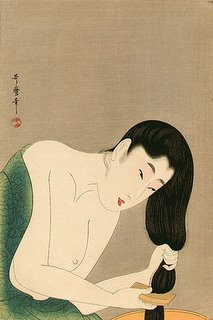 Utamaro Kitagawa, Bijin Combing Her Hair, 1750-1806 The key to create a wind-down period before bedtime is to create some space between your busy day and sleep time. “You can’t just work until 9 at night, and then stick your head on the pillow and fall asleep,” Khalsa says. So turn off the television, computer, and radio. Cut down on or eliminate evening classes and exercise that leaves you feeling amped up.
When you come home, honor this transition by playing relaxing music, lighting candles, or putting on your favorite pajamas and set your Zen Alarm Clock. Think of the yoga precept of pratyahara: Withdraw your senses in order to turn inward.
Our unique “Zen Clock” features a long-resonating acoustic chime that brings the meditation session to a gradual close, preserving the environment of stillness while also acting as an effective time signal.
adapted from yogajournal.com ‘Sweet Slumber’ by Nora Isaacs
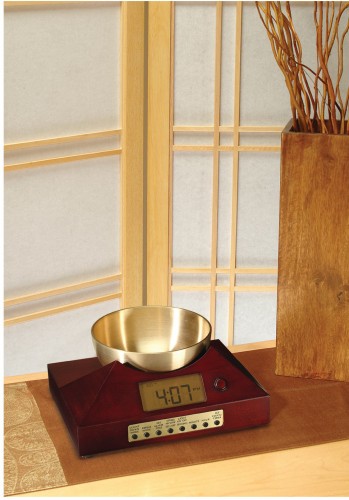 Zen Alarm Clock for a Gentle Awakening with a Bowl Gong
Now & Zen’s Chime Timer
1638 Pearl Street
Boulder, CO 80302
Posted in Bamboo Chime Clocks, Japanese Inspired Zen Clocks, Meditation Timers, Meditation Tools, mindfulness practice, Natural Awakening, Now & Zen Alarm Clocks, Progressive Awakening, Sleep Habits, Ukiyo-e, Well-being, Zen Timepiece by Now & Zen, Zen Timers
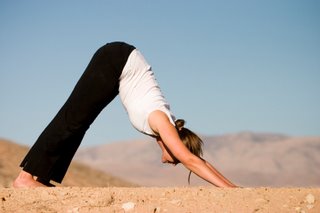 yoga downward dog pose This multipurpose pose stretches and releases tension in key parts of your body (shoulders, legs) while at the same time strengthening and toning them. Make it part of your regular practice and feel your energy soar.
Here’s How To Do It
Start on all fours on a yoga mat, with your hands aligned with your shoulders and your knees directly under your hips. The tops of your feet should be on the mat.
Inhale, curl your toes under, and spread your fingers. Exhale, raise your tailbone, and push into the mat with your hands. Elongate your spine, and straighten your legs. Keeping your head neutral and your back flat, activate the muscles in your arms and legs. Push your heels down toward the floor. Hold for four to five breaths. Bend your knees and relax. Set your Zen Yoga Timer to 30 seconds.
Refine Your Technique
As you incorporate the pose into your practice, use the following strategies.
1. Spread your fingers as wide as possible, pressing the base of your index fingers into the floor.
2. Keep your head between your arms or let it hang, whatever feels more comfortable.
3. Lengthen your spine, lifting your sitting bones up; imagine someone pulling your hips and back.
4. Keep your knees straight, but not locked. Hold the outer thigh muscles firm, and roll the upper thighs slightly inward.
5. Your heels may or may not reach the floor; keep stretching them, but don’t strain.
6. Hold your shoulder blades firm, drawing them in and down, toward your tailbone.
adapted from Body + Soul Magazine, November 2009 by Tania Hannan
Use our unique “Zen Clock” which functions as a Yoga Timer. It features a long-resonating acoustic chime that brings your meditation or yoga session to a gradual close, preserving the environment of stillness while also acting as an effective time signal. Our Yoga Timer & Clock can be programmed to chime at the end of the meditation or yoga session or periodically throughout the session as a kind of sonic yantra. The beauty and functionality of the Zen Clock/Timer makes it a meditation tool that can actually help you “make time” for meditation in your life. Bring yourself back to balance.
 Digital Zen Alarm Clocks, yoga timers with a chime
Now & Zen – The Yoga Chime Timer Store
1638 Pearl Street
Boulder, CO 80302
(800) 779-6383
Posted in Bamboo Chime Clocks, Chime Alarm Clocks, Meditation Timers, Meditation Tools, mindfulness practice, Now & Zen Alarm Clocks, Well-being, Yoga Timer, Yoga Timers by Now & Zen
« Previous Page — « Previous Entries
Next Entries » — Next Page »
|
|
|
|